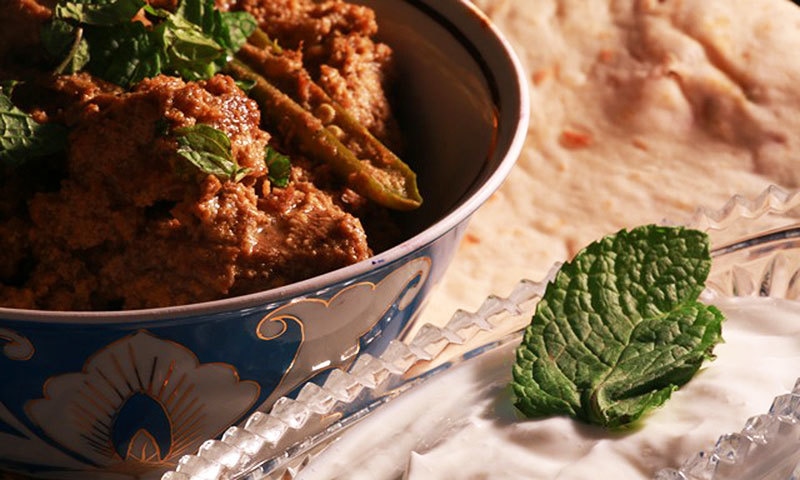Ever so rarely, each of us stumbles into that moment where we are transported into a beautiful time in the past; when nostalgia grips at the heartstrings and we understand the value of the world that was and the people that were.
The distinct aroma of the fragrant spices used in the cooking of achar gosht did just that for me.
All of a sudden, I was a chubby 12-year-old and nani amma was handing me a plate with a serving of achar gosht and a side of naan. The excitement and anticipation of the first bite, I distinctly remember thinking, 'nani amma makes the best achar gosht, I better get the recipe from her'.
I never did. Instead, I got it from my khala who follows her mother’s recipe.
 |
Achar Gosht is a South Asian masala dish which sports the tangy flavour and aroma of achar (pickle) with the richness of meat.
Also read: Processed: Pakistan's unhealthy trend
Lizzie Collingham in Curry: a tale of Cooks and Conquerors talks about the history and making of achar (pickle), and its significance to the people of the subcontinent:
"European travelers to 17th century India discovered that, with their meal the [people of the subcontinent] ate a wide range of achars, pickles and chutneys. Many of these were freshly made each morning.
"While preparing the spices for the main dish, the masalchi (the person grinding the spices) might grind together fresh green coriander leaves, green chillies and coconut to create a sharp, tangy, bright green paste. Other pickles and chutneys were more like preserves and the Europeans found them very useful when they travelled along the vast sub-continent.
"The Indians very rarely used vinegar, and their pickle was made by layering vegetables or fruit with oil and water. The mixture was flavoured with salt and spices and the jars were set in the hot sun where they were left to ferment in the hot sub-continental sun."
 |
This achar then gave birth to achar gosht. What served as an accompaniment to the main dish at the dinner dastarkhawn (dinner spread) metamorphosed into the main dish at the table.
The region of north Punjab is believed to have helped evolve this dish. However, Hyderabad lays a claim to it too, and since Hyderabadi cuisine plays host to masala dishes that boast of tang and stuffed masala chilli, and use spices similar to those used in the making of achar gosht.
The Hyderabad claim may just be true, says food historian Cunningham:
"The Bahmanid kingdom eventually broke up into a number of satellite states, one of which was Golconda, which later became known as Hyderabad. Here, the pulaos of the Persians combined with Hindu Deccani cookery, in which shredded coconut and coconut milk are vital ingredients and the tang of curry leaves, the astringent bite of fresh fenugreek leaves, and the sharp sour note of tamarind impart flavor. The meeting of the two styles gave rise to an elegant cuisine with unusual combinations, such as lamb cooked with tamarind."
 |
There are other legends; history also tells tales about how achar gosht came to be; an innovative cook got tired of making chutney and achar for everyday consumption with a daily main dish, and hence decided to combine the two. It is also said that it was in the kitchens of northern Punjab that leftover achar of several days was combined with meat; and voila, achar gosht came to be!
Also see: Food Stories: Kunna Gosht
Daughters are a wonderful thing to have, for mothers almost always pass on recipes from generation to generation. When the time came to make achar gosht I sat 'tsk tsk-ing' at not taking the recipe from my grandmother. Just then, my phone buzzed – Anjum Khala had sent over nani amma's heavenly recipe.
Here it is, finger-licking good, from my kitchen to yours.
Ingredients
 |
½ cup oil
1 kg goat meat (preferably leg or shoulder meat)
1 kg yogurt
Meethi seeds, saunf (fennel), kalongi, 1 tbsp. each (freshly ground)
1 large onion
Ginger and garlic (fresh, 1tsp. each)
¼ to ½ tsp. turmeric
Salt to taste
1 tsp. coriander powder
For Garnish
4 to 5 green chillies split in half lengthwise and soaked in lemon juice and fresh mint.
Method
Heat oil and brown sliced onions, adding ginger garlic, turmeric and coriander powder. Fry for a few minutes. Now add freshly ground masalas and cook on high heat for a few minutes, adding meat and stirring.
Maintaining a high heat, pour in yogurt bringing achar gosht to a boil. Simmer at medium heat until the meat is tender, adding a little water if required.
Once the meat is tender and the oil separates, add green chillies, seal lid and put on dum for five to 10 minutes.
Garnish with chopped mint and serve with hot naan.
 |
Explore more food stories here.
—Photos by Fawad Ahmed














































